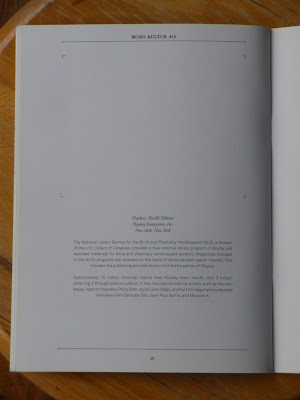
I'm attracted to magazines that create numerous issues out of a single, focussed idea. Something like Aggie Weston's Editions, where each issue comprised a series of poems chosen by a particular poet. It was a simple idea but it set up a series of subtle repercussions between the poet choosing and the poets selected, the magazines chapbook-like appearance absorbed the selected poems into the editor's own work.
Such ideas for magazines also seem, at least from the outside, to be a sustainable model. No worries about advertising or managing large numbers of contributers. The idea at the beginning pitches itself at a level the editor knows to be sustainable. Surely, such simplicity couldn't ever get out of control! Thus, at this years Publish and Be Damned Fair, there was Tony White's Piece of Paper Press, each issue comprising a single sheet of A4 paper, photocopied in an edition of 150, ongoing since 1994.
Perhaps the upper end of such an idea - where the small idea also begins to acquire more extensive, art world distribution - is provided by the Berlin produced mono.kultur. Published quarterly, each issue comprises a single interview. All issues follow the same stapled A5 format, but within that the layout, type of paper, the overall concept for the issue, come out of the dialogue with each artist and their work. A short introduction usually precedes around twenty pages of text.
I've picked up the last three issues of mono.kultur at the Serpentine Gallery bookshop. Taryn Simon: Kaleidoscope of Entropy (#15) included photo's from the photographer's series An American Index of the Hidden and Unfamiliar in an envelope at the back of the magazine. Throughout the text were white squares, complete with corner markings and titles, with the suggestion that the reader themselves complete the issues construction. For Miranda July: Best at Belonging to Yourself (#16) the magazine slotted into a pocket formed by a large double-sided poster that documented a number of July's art projects, a design solution that emphasized the improvisatory, DIY construction of many of the documented works.
The latest issue #17 features an interview with the Polish artist Pawel Althamer. The interview itself is printed - unlike the previous issues - on glossy paper, whilst the issues outer sheets are on rougher stock, comprising photo's of the work and individuals of the Nowolopie Group, a ceramics workshop Althamer has taught
for thirteen years, whose members all suffer from multiple sclerosis, and whose work Althamer has presented, documented and sold internationally. For example, this years Double Agent show at the ICA contained both ceramics and a video of one of the groups classes.
This way of structuring the magazine is reflected in the conversation itself and Althamer's work, which, with invitations from galleries in various countries, leads him away and back to the Nowolopie Group. It also more broadly reflects his practice of inviting others to occupy spaces or exhibitions he has been awarded. For example, for his 2006 show at the Centre Pompidou he selected eleven art students who collaborated on a filmed shadow play, with Althamer himself contributing a film that related the history of the project.
Like the Simon and July issues, the interview offers Althamer a chance to run through his career. mono.kultur interviews tend to be done by critics and curators - this one is provided by Adam Szymczyk - but they don't actually do any criticizing, more they provide a structure to enable the artist to lead us through his career and views. This has its advantages in that the overall feel is one of intimacy - Althamer talks about the numerous exhibition proposals that have been rejected, his marriage break up, his experiences of God - but it has the disadvantage of seeming firmly based on the assumption that nothing the artist says be challenged.
This is perhaps more evident in the current issue because Althamer is interested in playing and provoking around notions of the artist. He emerges both as a kind of artist-bureaucrat, keen to set processes in motion and become invisible himself, and also as a Beuysian shaman, talking about his encounters with God, possessing a clear sense that his own ability and charisma hold everything together. This leads to some curious statements it would have been good to explore further. At one point, Althamer talks of how he and his art group pray for miracles - and, lo and behold, their work is selected for and sold at Art Basel Miami.
I don't want to appear churlish about the precise forms divine intervention might take, but Althamer's sense of the divine working through booming art sales did seem to warrant further questioning. And if it's not divine will then: "The art world is like a corporation and, as a healthy employee, I have no reason to complain. It's like an annual bonus all year round." (17) Connecting this back to the magazines design, I can't help but notice how images of members of the Nowolipie group group are over-printed in patterns of pixillated dots that makes them highly aestheticized and all but unrecognizable. Was this a collective decision or a recognition of the limits of participation?
This highlights a broader problem for mono.kultur. It straddles a difficult boundary between its form and its content. The uncritical, artist- friendly tone of the interviews means that one reads the magazine largely for its design values, the way it places those words within a particular visual context. At the same time, this is an A5 stapled booklet, deliberately evocative of cheaply produced zines, so the reason for reading it is less any visual thrills than the urgency of its content, something that needs a more challenging encounter to sustain interest. It's a tension that, unresolved, could doom a magazine to inconsequentiality.



